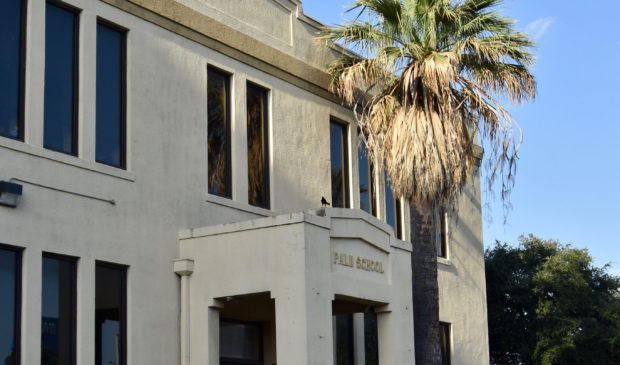City seeks input on vision, plans for downtown’s Palm District
Wednesday, May 5, 2021 by
Chad Swiatecki Residents can begin offering their thoughts to the city about the future use and look of the Palm District, a section of downtown that features historic structures and is surrounded by rapid growth and development.
The city will hold a series of virtual meetings and surveys to let those interested in the district share their thoughts on matters such as the future of the historic Palm School, the expansion of the Emma S. Barrientos Mexican American Cultural Center, and how the area that was once a focal point for Austin’s Latino community can better reflect its heritage.
The fate of the district has been a matter of increasing importance in recent years. Before the onset of the Covid-19 pandemic, city and county leaders were engaged in a highly public debate over whether the county should sell the Palm School for private development to maximize its cash value, or work with the city to convert it from office use into a community gathering place.
The city strongly desired that the county not sell the school property for private development. In spring 2019, Council adopted a resolution that attempted to set up a process for building community consensus around the future of the Palm District and several connected assets including the Austin Convention Center and the Rainey Street District.
The public input process, which includes virtual meetings on June 15-16, is part of the district’s visioning phase that will run into the summer with active planning lasting into the fall. Adoption of a formal plan for the district is expected to take place in spring 2022.
Council Member Kathie Tovo, whose district includes the Palm District area, said the city and Travis County leaders need to reopen talks on the eventual use of the school property. She said if the city were able to purchase the property from the county it would likely be converted from its office use to provide a cultural focal point for the district.
“I’m still keenly interested in seeing it remain a public building. I’d like to see a more public use in the building and those county offices move out, so whether the county continues to own it and works with the community to find a new purpose for that building, or whether they partner with the city to do something along those lines, there’s tremendous potential and a lot of community support for maintaining that building with a real vibrant, active public use,” she said.
“One very important intention is to do all this work with the primary focus on recognizing and celebrating the history of the Mexican American families who once lived in that area.”
Tovo said money for improvements throughout the district could come from a partnership between the city and county, use of some of the city’s funding for historic preservation, and some money generated by the tax increment financing district created to fund the Waller Creek tunnel.
Council Member Vanessa Fuentes was among the community organizers who pushed for a plan for the district before she was elected last year. She said there is strong support in the community to create a cultural heritage district based largely around the Palm District to reflect the roots of residents who have been displaced in recent generations.
“I’m excited to see the city is opening up the stakeholder process and including the community in the visioning of the Palm District,” she said. “One piece I want to amplify and uplift is around the Mexican American Cultural Heritage District that we have not formally established but is part of the conversation. With the transformation of the Palm District, the two of those pair very nicely with that area stretching to Republic Square to create a nice corridor.”
Fuentes said public improvements that should be included in the long-term plan include completing an expansion of the MACC, creating a gathering place for cultural celebrations, and providing public transit options to let Latinos living outside of downtown easily take part in events involving their heritage.
Paul Saldaña, a community organizer who also helped with the push that led to the 2019 Council action, said the city needs to be as inclusive as possible for residents’ wishes for the district that has been a topic of debate and discussion for more than 30 years.
“Those conversations have gone on for more than 30 years and the fact that Austin is growing leaps and bounds … there’s a lot of conversations about displacement, gentrification but also the loss of historical context for where we have been as a city,” he said. “Specifically for our community, the contributions of Mexican Americans, Latinos and the indigenous population is something that needs to be preserved and recognized moving forward through that process.”
Photo by Nick Amoscato made available through a Creative Commons license.
The Austin Monitor’s work is made possible by donations from the community. Though our reporting covers donors from time to time, we are careful to keep business and editorial efforts separate while maintaining transparency. A complete list of donors is available here, and our code of ethics is explained here.
You're a community leader
And we’re honored you look to us for serious, in-depth news. You know a strong community needs local and dedicated watchdog reporting. We’re here for you and that won’t change. Now will you take the powerful next step and support our nonprofit news organization?






